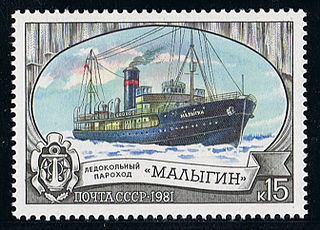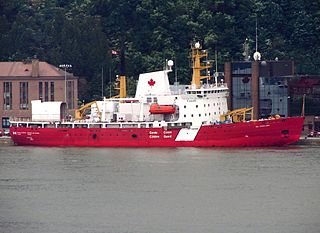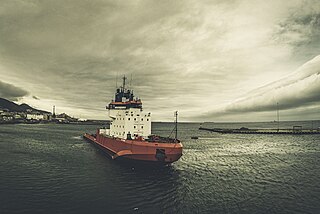
An icebreaker is a special-purpose ship or boat designed to move and navigate through ice-covered waters, and provide safe waterways for other boats and ships. Although the term usually refers to ice-breaking ships, it may also refer to smaller vessels, such as the icebreaking boats that were once used on the canals of the United Kingdom.

CCGS Terry Fox is a Canadian Coast Guard heavy icebreaker. She was originally built by Burrard-Yarrows Corporation in Canada in 1983 as part of an Arctic drilling system developed by BeauDril, the drilling subsidiary of Gulf Canada Resources. After the offshore oil exploration in the Beaufort Sea ended in the early 1990s, she was first leased and then sold to the Canadian Coast Guard.

CCGS Amundsen is a Pierre Radisson-class icebreaker and Arctic research vessel operated by the Canadian Coast Guard. The vessel entered service in 1979 as Franklin and was renamed Sir John Franklin in 1980 and served as such until 1996. Declared surplus, the vessel was used as an accommodation ship in Labrador in 1996 and placed in reserve in 2000. In 2003, the ship was reactivated and underwent conversion to an Arctic research vessel. The ship recommissioned as Amundsen.

USCGC Mackinaw (WAGB-83) is a 290-foot (88 m) former Coast Guard icebreaker on exhibit as a museum ship at the Icebreaker Mackinaw Maritime Museum in Mackinaw City, Michigan. The vessel has been known as the "Queen of the Great Lakes"; the site states that "she was built during World War II to meet the heavy demands of war materials and transportation during the winter months".

USS Edisto (AGB-2) was a Wind-class icebreaker in the service of the United States Navy and was later transferred to the United States Coast Guard as USCGC Edisto (WAGB-284). She was named after Edisto Island, South Carolina. The island is named after the Native American Edisto Band who inhabited the island and the surrounding area. As of 2011 there is a namesake cutter USCGC Edisto (WPB-1313). The newer Edisto is a 110-foot Island-class patrol boat and is stationed in San Diego County, California.

The steamship Malygin (Малыгин) was a Soviet icebreaker of 3,200 tonnes displacement. She was named after Stepan Malygin.

CCGS Des Groseilliers is a Pierre Radisson-class icebreaker in the Canadian Coast Guard. The vessel is named after Médard Chouart des Groseilliers (1618–1669) a close associate of Pierre-Esprit Radisson in explorations west of the Great Lakes and the founding of the British Hudson's Bay Company. The ship entered service in 1982. The vessel has participated in a number of research voyages, including Ice Station SHEBA. As part of the Surface Heat Budget of the Arctic Ocean experiment conducted in the Arctic Ocean from October 1997 to October 1998 to provide polar input to global climate models, Des Groseilliers was allowed to be frozen into the ice for the Arctic winter, to serve as a base for scientific researchers.

Ice class refers to a notation assigned by a classification society or a national authority to denote the additional level of strengthening as well as other arrangements that enable a ship to navigate through sea ice. Some ice classes also have requirements for the ice-going performance of the vessel.

CCGS D'Iberville was a Canadian Coast Guard icebreaker that was in service from 1952 to 1983 and was Canada's first modern icebreaker. The ship commissioned as CGS D'Iberville for the Department of Transport's Marine Service, using the prefix "Canadian Government Ship", D'Iberville was transferred into the newly-created Canadian Coast Guard in 1962. When launched, she was the largest icebreaker in use by Canada post-World War II until CCGS John A. Macdonald was put in service. In 1984, the icebreaker was renamed Phillip O'Hara before returning to her old name in 1988. In 1989 the vessel was sold for scrap and broken up at Kaohsiung, Taiwan.

Fednav is a privately owned Canadian company in the maritime transport industry, involved in transporting over 30 million tonnes of bulk cargo and break bulk cargo worldwide. Its fleet comprises approximately 120 long-term and spot chartered vessels. The fleet includes most of St. Lawrence Seaway's maximum-sized bulk carriers, Supramax, and Panamax vessels.

The first icebreaker Krassin, or Krasin, was built for the Imperial Russian Navy as Svyatogor. She had a long, distinguished career in rescue operations, as well as a pathfinder and explorer of the Northern Sea Route. She has been fully restored to operating condition and is now a museum ship in Saint Petersburg.

CCGS Captain Molly Kool is a Canadian Coast Guard converted medium class icebreaker. She was originally built as an icebreaking anchor handling tug Vidar Viking for Trans Viking Icebreaking & Offshore in 2001. The vessel was acquired by the Canadian Coast Guard in August 2018 and was commissioned in May of the next year after refit.

CCGS Pierre Radisson is the lead ship of her class of icebreakers. Constructed and operated by the Canadian Coast Guard, the vessel is based at Quebec City on the Saint Lawrence River. The ship was constructed in British Columbia in the 1970s and has been in service ever since. The vessel is named for Pierre-Esprit Radisson, a 17th-century French fur trader and explorer.

CCGS Martha L. Black is the lead ship of her class of light icebreakers of the Canadian Coast Guard. The ship was built in 1986 in Vancouver, British Columbia by Versatile Pacific Shipyards Limited as part of the CG Program Vessels. The vessel was mainly designed as a high-endurance, multi-tasked boat. Most of her duties are along the St. Lawrence River and St. Lawrence Seaway as she is able to handle the ice thickness there.

Vladimir Ignatyuk is a Russian icebreaking anchor handling tug supply vessel. She was built by Burrard-Yarrows Corporation in Canada in 1983 as Kalvik as part of an Arctic drilling system developed by BeauDril, the drilling subsidiary of Gulf Canada Resources. After the offshore oil exploration in the Beaufort Sea ended in the early 1990s, she was sold to the Canadian shipping company Fednav in 1997 and renamed Arctic Kalvik. In 2003, she was purchased by Murmansk Shipping Company and transferred to Russia.
Robert LeMeur was an icebreaking platform supply vessel used to support oil exploration in the Beaufort Sea. Built in 1982 by Burrard Yarrows Corporation in Vancouver, British Columbia, she was part of the fleet of Canadian icebreakers, drillships and support vessels operated by Canadian Marine Drilling (Canmar), the drilling subsidiary of Dome Petroleum and later Amoco Canada Petroleum Company.
Miscaroo was an icebreaking anchor handling tug supply vessel built by Vancouver Shipyards for BeauDril, the drilling subsidiary of Gulf Canada Resources, in 1983. She was part of a fleet of Canadian icebreakers used to support offshore oil exploration in the Beaufort Sea. In the 1990s, the vessel was acquired by Canadian Marine Drilling (Canmar) and renamed Canmar Miscaroo. In 1998, she was purchased by Smit International and served in the Sakhalin oil fields as Smit Sakhalin until 2017 when the 34-year-old icebreaker was sold for scrapping in China.
Zhong Shan Da Xue Ji Di is a Chinese icebreaker owned by the Sun Yat-sen University. She was built in 1983 as an icebreaking anchor handling tug supply vessel (AHTS) Ikaluk for BeauDril, the drilling subsidiary of Gulf Canada Resources, to support offshore oil exploration in the Beaufort Sea. In the 1990s, the vessel was acquired by Canadian Marine Drilling (Canmar) and renamed Canmar Ikaluk. In 1998, she was purchased by Smit International and served in the Sakhalin oil fields as Smit Sibu. In 2009, she was acquired by FEMCO Management and in 2012 given back her original name. Ikaluk was sold to China in February 2018 and renamed Beijing Ocean Leader. In late 2021, the vessel was acquired by its current owner.

Kigoriak is a Russian icebreaking anchor handling tug supply vessel. Built by Saint John Shipbuilding & Dry Dock Company for Canadian Marine Drilling (Canmar) in 1979 as Canmar Kigoriak, she was the first commercial icebreaking vessel developed to support offshore oil exploration in the Beaufort Sea.















